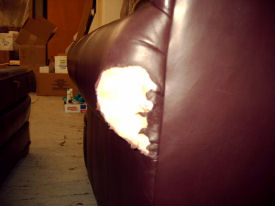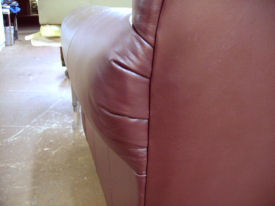

We love our pets. But, they can be destructive. In fact, the most common problem brought to us at Advanced Leather Solutions is pet damage to fine leather goods.
Whether it is chewed leather (as shown in the picture above), cat or dog claw marks, urine saturation, discoloration from flea medication, or general wear-and-tear caused by our pets, these problems can range from relatively minor aesthetic issues to a seemingly ruined piece of furniture.
If your leather has suffered animal damage, we’re here to help you return your piece to its former beauty. As leather repair and restoration technicians we have experience with a full range of culprits: cats, dogs, birds, a wide variety of rodents, various reptiles, and so on. Below are specific examples of pet damage.
Pet Urine
Typically there are four issues - chemical pH damage, staining, odor, and bacterial growth.
Pet urine (particularly cat) is acidic. It alters leather’s pH causing structural damage to the leather’s integrity. Often there is staining and offensive odor (cat urine tends to be the most caustic, and difficult to remedy). Simply masking the odor with an odor-eliminator product rarely works. Even if the product masks the odor for you, an animal’s sense of smell is vastly superior to yours. They will be drawn back to the area and typically repeat the behavior.
If you have a urine issue, we can create a custom restoration kit for you including the critical components of an odor neutralizer, anti-bacterial cleaning agent, pH correction products to stop the structural damage to the leather, and a color restoration system to hide the staining. Call us 800-541-5982 or e-mail us and we’ll construct a solution for you.
In the event the exposure has been repeated and severe, some leather panel replacement and internal stuffing may be required. We’re happy to assess the damage and advise you on an appropriate course of action.
Dog-chewed Leather
Man’s best friend occasionally is not your leather furniture’s best friend. Dog chews can be remarkably devastating. A cushion torn apart, the front of an arm missing, a corner gnawed on your favorite leather may bring you to tears (or rage) as you ponder what may seem to be the only option - buying new furniture. However, it doesn’t have to be the case. We offer an affordable alternative. For example, if it’s a cushion casing that is destroyed, send the remnants to us and we’ll construct a perfectly color-matched new one for you.
If the damage is on the frame, we can guide you in working with a local upholsterer to have the damaged areas replaced with appropriate leather, and then our DIY Leather Restoration System can be used to make all leather panels (new and old) match to the original.
Small areas of damage may be resolved using our repair products and processes. Perhaps our stitching kit can be used to take in a seam on a loose pillow to hide the damage.
We’re here to help. Send us photos via email and we’ll advise you on the best approach for your situation.
Cat-scratched Leather
Cat scratch damage on leather is the number one repair issue we resolve in our restoration studio. The cat claw damage can be light abrasions of the color coat, tiny pock marks, deep punctures, chatter marks with flaps of leather, or, in severe cases, shredded leather. We repair in excess of 10,000 individual cat scratches a year. So, we are very practiced at it. And, we’re happy to share that information directly with you. The end result typically is an invisible repair.
We have detailed written instructions supported by a DVD video that demonstrates the cat scratch repair technique. These instructions come with our cat scratch leather restoration system.
Like a severe dog chew, cat-claw shredded leather may be too badly damaged for effective repair. So, it’s resolved with selective panel replacement. Working with a local upholsterer and with our guidance, the damaged leather sections can be replaced with appropriate leather, and the restoration system is then used to recolor all leather panels so everything matches.
Dog-claw Marks
Dog claw marks typically are “chatter” marks across the surface. Each scratch line is the width of the dog’s claw and can range from several inches to 1-2 feet in length. They are normally from a toy or treat slipping down between the seat and the backrest, or the dog circling, nesting before lying down.
Light to moderate clawing often is resolved through the normal restoration process - sometimes with additional sanding and extra application of color. Heavier scratching may require the application of leather repair compound and additional sanding and color to disguise the damage.
While not as common as cat claw marks, dog scratching is a project we see frequently. Like the cat claw damage, there is a specific technique to resolve the dog scratches. We’re here to help. Let us build a custom dog scratch DIY leather restoration system for you. Call us today 800-541-5982. Or, send us an email with photos and we’ll take it from there.
Flea Medication Bleaching of Leather
Unless witnessed first hand, people often do not know that flea medications such as Advantix® or Front-line® are the cause of bleached or discolored areas that have “spontaneously” appeared on their furniture. It’s not uncommon to see the evidence any place where the animal rubbed against the leather shortly after the flea medication was applied.
Flea medication often has a solvent carrier designed to allow the active ingredients to migrate through the oils on the pet’s coat and into the pet's skin. If the pet is not kept away from the leather for at least an hour, they will often rub the medication application site against the leather or shake themselves and create a spray of medication that creates little bleached spots where the droplets land.
Our DIY leather restoration system includes preparation procedures ensuring that any residual flea medication on the leather is removed. The resulting color application disguises the affected areas.
return to top of page.